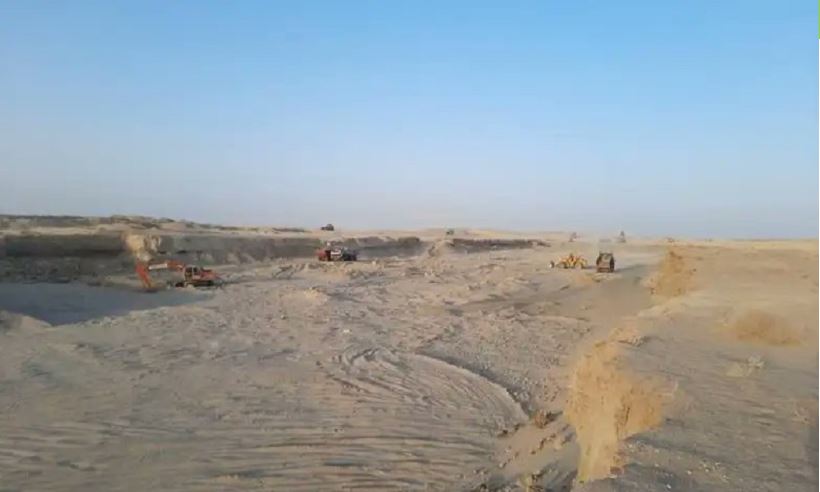CABAR.asia reported on May 30 that its correspondent has visited the border area between Uzbekistan and Afghanistan to see how the construction of the Qosh Tepa canal by Afghanistan is affecting the irrigation system in Uzbekistan.
Amid global climate change and worsening water shortages in Central Asian countries, the Qosh Tepa Canal construction on the Afghan side of the Amu Darya River valley reportedly causes particular concerns, especially in Central Asian downstream nations of Uzbekistan and Turkmenistan. The canal is expected to provide water to millions of Afghans suffering from regular droughts.
CABAR.asia notes that according to a special document by the Ministry of Water Resources of Uzbekistan, after the launch of the Qosh Tepa canal, the Taliban will be able to receive an additional 4-4.5 billion cubic meters of water from the Amu Darya annually.
Meanwhile, now, with the annual water withdrawal limit from the Amu Darya and Syr Darya river basins being 64 billion cubic meters, Uzbekistan reportedly receives 20% less water than the established limit allows.
Experts in Uzbekistan are concerned that the lack of advanced canal construction methods could significantly increase the loss of water from this transboundary river leading to even greater problems within its basin.
Recall, the self-proclaimed Islamic Emirate of Afghanistan set in motion an ambitious plan for the Qosh Tepa irrigation canal, a potential lifeline for drought-ridden Afghanistan, in March 2022. However, its construction casts a looming shadow over Central Asian downstream nations of Uzbekistan and Turkmenistan, exacerbating water scarcity threats.
The Qosh Tepa canal’s reach spans an impressive 285 kilometers, boasting a width of 100 meters and a depth of 8 meters.
Interestingly, the Qosh Tepa Canal project had been in the works for several years before the Taliban ascended to power. The groundwork and feasibility studies were reportedly initiated during Afghanistan’s former government, supported by USAID. However, it was under the Taliban’s direction that the project gained tangible momentum.
Assessing the quality of the canal’s construction reportedly raises serious doubts. The construction methods employed appear remarkably rudimentary, with a mere “digging” approach devoid of proper reinforcement or lining for the canal’s bottom and banks. Such an approach poses a grave risk, as significant water losses may occur due to seepage into the dry, sandy soil. The resulting loss of water in canals exacerbates the already pressing issues of salinization and waterlogging in irrigated lands, amplifying the risks of water loss to an alarming extent.
The issue of canal construction holds significant transboundary implications, particularly for Central Asian countries. Qosh Tepa canal’s construction casts a profound shadow of influence over the neighboring states of Central Asia, unleashing substantial repercussions. Diverse assessments suggest that in the span of 5-6 years, upon the canal’s completion and operation, Turkmenistan and Uzbekistan will face a notable decline in their average water intake capacity along the middle and lower reaches of the transboundary river -- dropping from 80% to 65%.
The Diplomat notes that although previous agreements regarding the Amu Darya had been negotiated between the Soviet Union and the government in Kabul, going back to 1946, these treaties never directly addressed the issue of water-sharing on the Amu Darya. Later agreements, like the post-Soviet Almaty Agreement, never included Afghanistan as a signatory in any negotiations regarding the use of water in the basin.
Experts note that Afghanistan's exclusion from the UN Convention on the Protection and Use of Transboundary Waters (1992) bears significant consequences. This convention, a cornerstone of transboundary river and lake management, defines crucial concepts like "transboundary impact," essential in assessing the environmental, social, and economic ramifications of water resource management. Lacking adherence to these principles, Afghanistan embarks on canal construction without being bound by international norms. As a result, agreements governing the Amu Darya's use remain absent between Afghanistan and Central Asian countries.
The Diplomat notes that without a real understanding in Kabul, or for that matter any Central Asian nation, of the rights Afghanistan had to the Amu Darya’s waters, the best the regimes in the region can do is look to precedent. The current agreement governing the basin, the Almaty Agreement, takes as its basis for water allocation divisions that were originally envisioned in the Soviet-era Protocol 566, which only assumed that Afghanistan would divert 2.1 billion cubic meters, far less than the potential 10 billion that the Qosh Tepa canal might divert.







